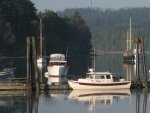hardee
New member
- Joined
- Oct 30, 2006
- Messages
- 12,637
- Reaction score
- 2
- C Dory Year
- 2005
- C Dory Model
- 22 Cruiser
- Hull Identification Number
- Brat # 2202
- Vessel Name
- Sleepy-C
I am curious to know from those who single hand, or have, what are some of the safety practices that you use, or know of, to enhance the single hand experience and increase the safety issues.
I have been doing a fair amount of single handing and even though I think I am a pretty safety conscious boater, I am thinking there are things I could learn, and/or do that could improve my chances of avoiding an unintentional dunking….. or worse.
Here are some of my practices that have worked so far:
PFD, ON always. PFD has a strobe and a handheld VHF attached.
Radio Check when leaving the harbor. (Fortunately we have a robot radio in the area. VHF28, for a recorded check.) Done with both fixed mount VHF’s.
Weather check prior to launch or leaving dock.
Float plan, filed by phone with leaving from where and destination with an ETA.
Fuel availability prior to leaving and in route and battery monitoring in route.
Chart Plotter and stand-alone GPS for backup, on always.
Radar, on always.
AIS on always.
With Auto Pilot running, stay out of the cockpit at anything above an idle, (for retrieving or deploying fenders.)
Stay in the cabin or cockpit, out of the V-birth and off the bow deck or cabin side gunnels.
Maintain station awareness, scan gauges and screens regularly and frequently, BUT maintain an eye out for floaters, (forward), and traffic, (all around).
Do not be shy about using the VHF if there is a concern or confusion regarding other traffic.
Rest when weary.
I would be happy to hear from any one regarding improvements or additions to this that could be helpful.
Harvey
SleepyC :moon

I have been doing a fair amount of single handing and even though I think I am a pretty safety conscious boater, I am thinking there are things I could learn, and/or do that could improve my chances of avoiding an unintentional dunking….. or worse.
Here are some of my practices that have worked so far:
PFD, ON always. PFD has a strobe and a handheld VHF attached.
Radio Check when leaving the harbor. (Fortunately we have a robot radio in the area. VHF28, for a recorded check.) Done with both fixed mount VHF’s.
Weather check prior to launch or leaving dock.
Float plan, filed by phone with leaving from where and destination with an ETA.
Fuel availability prior to leaving and in route and battery monitoring in route.
Chart Plotter and stand-alone GPS for backup, on always.
Radar, on always.
AIS on always.
With Auto Pilot running, stay out of the cockpit at anything above an idle, (for retrieving or deploying fenders.)
Stay in the cabin or cockpit, out of the V-birth and off the bow deck or cabin side gunnels.
Maintain station awareness, scan gauges and screens regularly and frequently, BUT maintain an eye out for floaters, (forward), and traffic, (all around).
Do not be shy about using the VHF if there is a concern or confusion regarding other traffic.
Rest when weary.
I would be happy to hear from any one regarding improvements or additions to this that could be helpful.
Harvey
SleepyC :moon

